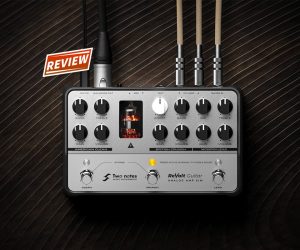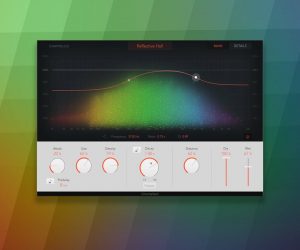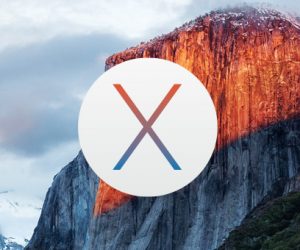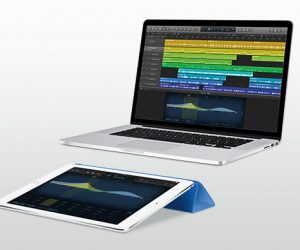
Apple Notes 123
iPad’s Coming of Age?
I reckon we’re mightily close to the point where an iPad can be used for serious recording. I know many already do, but for me it’s still lacking. I’ll get to why a little later.
Of course, you’ll need an interface that is savvy to iPad connection. There’s actually dozens of interfaces accessible by an iPad, as long as they’re USB Class 2.0 compliant they can be tethered to an iPad for multitrack recording. Yes, USB is the only option for iPad I/O as the interface needs to be connected with an Apple Camera Connection Kit (for older 32-pin connectors) and a powered USB hub to keep the iPad powered, or the Lightning-to-USB Camera Adapter for Lightning port iPads.
Don’t be swayed by the ‘Camera’ nomenclature — Apple market the connector as a device to shift photos and video from your camera to the iPad — but it’s suitable for all USB peripherals. There are two flavours of the Lightning-to-USB Camera Adapter: standard USB 2.0 for $45, and the Lightning to USB 3 Camera Adapter for $59. While only 2017-model iPad Pros offer USB 3.0, get the Lightning-to-USB 3 Camera Adapter anyway as it has an additional Lightning port allowing you to power the iPad while it’s connected to an interface. It will negate the need for a USB hub and you’re relatively future-proof when you move on to a better spec iPad; it’s $14 well spent.
SMILE FOR THE CAMERA
Recently, a number of USB audio interfaces have been released which adhere to Apple’s licensing program for iPad and iPhone peripherals. The MFi Program (Made for iPhone/iPod/iPad) covers peripherals such as game controllers, headphones, ethernet adapters, memory card readers, and audio/MIDI interfaces. These interfaces will typically ship with a Lightning cable specifically designed to connect to your iPad and won’t require the additional expense of a Lightning-to-USB Camera Adapter. MFi standard devices include Apogee’s Quartet and Duet, Presonus’ AudioBox iOne and iTwo, Avid’s Fast Track Duo and Solo, Focusrite’s iTrack Solo, and single input units such as IK Multimedia’s iRig devices.
MFi-compliant interfaces primarily inhabit the entry-level space, with interfaces offering from one to eight inputs. If you’re after 16 or 24 inputs you’ll find yourself in non-MFi territory. No big deal, as the Lightning-to-USB Camera Adapter will cover you. Here you can spend some serious cash, with interfaces from the likes of Prism Sound, MOTU, upper echelon Presonus and Focusrite systems, RME and Antelope. If you’re more of a console recordist there are systems from Behringer, Allen & Heath, and Soundcraft which will record 24 discrete tracks.
Before we get to software, I’ll displace some fears regarding the iPad’s processing power. It’s easy to jump to the conclusion that an iPad is a somewhat benign computer, but nothing could be further from the truth. Take for example the current iPads. The ARM A9 processor is a dual-core 2GHz processor, and the A10X found in the iPad Pro units offers six 64-bit cores that are divided in two halves. Three high performance cores run at up to 2.39GHz, with three power saving cores used for lesser demanding tasks. It’s called ‘big.LITTLE’ technology, and shuffles instructions to either set of processors dependent upon processing requirements, consequently keeping the processor within heat margins. So in a nutshell, three cores running at 2.39GHz will easily record 24 tracks, as will a dual-core 2GHz processor. In fact, you’ll record 24 tracks at 44.1k on a first-gen iPad, and you can achieve 48-track counts with later models — even up to 96k.
SOFT OPTIONS
Now, software. There’s ample choice available on the App Store, but if you’re doing simple two-track recordings you can’t go past GarageBand. It’s cheap (free) and will tackle up to 32 tracks. However, while it records at 24-bit, you’re limited to 44.1k — not that big a deal if you’re recording a band. Plus it dovetails impeccably with Logic Pro X. If you’re aiming for something with more of a DAW feel or 96k resolution you should investigate WaveMachine Labs’ Auria Pro. Auria Pro offers 24-channel input, 44.1, 48, and 96k resolution, up to 32 buses, track freeze, bounce, ample DSP for EQ and compression, delay compensation, AAF export so you can shunt your project out to a multitude of desktop DAWs, the list goes on and on. At $80 it’s the best you can buy. It comes in a few flavours and price points, with the lowest ‘LE’ version costing $31. You can kick off with the LE version and upgrade with in-app purchases as you go. Prepare to be amazed.
11 REASONS
Getting back to the reason I’m convinced iPad recording is almost of age — quite simply, is the impending release of iOS 11. In September we should see iOS merging toward a singularity with macOS. iOS 11 provides a dock-like macOS — who’d have thought! It also features an app named ‘Files’. The Files app is much like a single window viewed as Columns (command-3) in macOS, and it allows you to move files around the iPad almost like you’re working on a ‘real’ macOS device. If you’ve ever needed to shuffle files around between an iPad and a desk- or laptop you’ll be champing at the bit for this update. If you’re dealing with large audio files from a recording project iOS 11 will make this tonnes easier. But be warned. iOS 11 is strictly a 64-bit operating system, and earlier iPads don’t make the cut. iPad mini 2 through to 4 models will accept iOS 11, as will iPad Air and up models. All iPad Pros are 64-bit.
PADDING AROUND
We are without doubt at the crossroads now, where the iPad can be considered a viable recording option. The software is capable, the iPad processor is more than capable. A 512GB model will easily tackle a day’s recording with no moving parts and completely silent operation — the grail of digital recording. Combine these features with lightweight portability and a suitable interface, and you’ve got a professional recording rig. Gold.
















RESPONSES